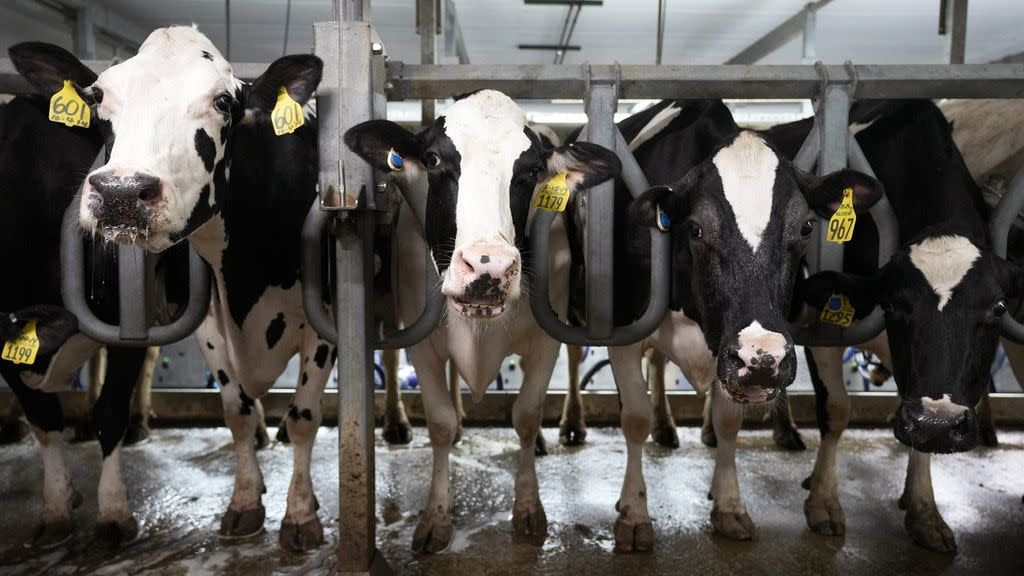US cases of avian flu in cattle are causing concern. How prepared is Europe for the bird flu threat?

A strain of bird flu that jumped to dairy cows and then farmworkers in the US this spring could become a global health risk – but the extent of the threat is unknown and officials in Europe and elsewhere could be caught unprepared if it escalates.
The US cases are the latest upswell of a highly pathogenic avian influenza (H5N1) that has been circulating among migratory birds and mammals in recent years, mostly in Europe and the Americas.
Since March, the strain has cropped up in 145 cattle herds in 12 US states and infected four dairy workers, all of whom went on to recover from their illnesses.
There has been no evidence of human-to-human spread, which is a key marker of pandemic threat, while no human cases of the strain have been reported in Europe, and the European Centre for Disease Prevention and Control (ECDC) says the general public is at low risk of infection.
Even so, experts say there are enough warning signs that European countries should already be monitoring the virus and getting ready to respond quickly if that changes.
Waiting until the virus emerges among people on this side of the Atlantic would allow H5N1 to spread unchecked for long enough that it becomes difficult, if not impossible, to quash.
Transmission from cows to humans
“Things can change very fast, and it's difficult to put a precise timeline on it, because it depends on what the emergence process looks like,” Colin Russell, an evolutionary biologist at Amsterdam University Medical Center and chair of the European Scientific Working Group on Influenza and Other Respiratory Viruses (ESWI), told Euronews Health.
“If we don't know what we're missing, we could already have a problem on our hands,” Russell said.
The US outbreak has scientists worried as it’s the first time H5N1 has been documented in cattle, making it far riskier that the virus will spread to humans, and because H5N1 has been lethal in the past.
Between 2003 and 2024, H5N1 caused 889 illnesses and 463 deaths in 23 countries, a fatality rate of 52 per cent, according to the World Health Organization (WHO).
While the US strain doesn’t yet have the mutations that enable rapid spread between people, researchers said this week that the inflection point could be closer than previously thought, after they found signs of transmission between small animals in lab tests.
“It’s a little bit concerning, because it means that the virus does have more ability than typical highly pathogenic avian influenza viruses to spread by air from mammal to mammal,” Thijs Kuiken, professor of comparative pathology at the Erasmus University Medical Centre, told Euronews Health.
His research focuses on avian flu and other emerging viral diseases but he was not involved with the recent study.
Taking steps against H5N1
Kuiken and other experts say the risk from H5N1 to people around the globe appears to only be moderately higher than before the US cattle outbreak, but that even a slightly elevated risk is enough to raise concerns.
“The most likely [outcome] is that it will die off, rather than posing a significant change and enough changes to actually spread in other countries,” Munir Iqbal, head of the avian influenza and Newcastle Disease group at the Pirbright Institute, told Euronews Health.
But in places where H5N1 is already present, “the virus is unseen, and therefore everything [should be] treated like something infectious”.
Some countries are taking their own steps to prepare for H5N1, regardless of whether the US dairy cattle strain poses the ultimate threat in Europe.
Finland, for example, is offering vaccines to 10,000 workers who are at high risk of coming into contact with bird flu, and is also monitoring fur farms for potential cases throughout the summer.
Meanwhile, German and Italian researchers have tested samples from cattle and goats in areas where the virus has circulated among birds in recent years, and found no evidence that they were infected.
Kuiken said several other European countries, including the Netherlands, Spain, Norway, Sweden, France, and Belgium, will soon launch their own studies.
“When you all of a sudden realise that a species that you haven't been paying much attention to could have been infected, you want to look retrospectively to see whether it occurred,” Kuiken said.
“Looking into the future, many labs are now taking into account that they can't rule out the possibility that such unusual epidemiological events also will happen in Europe”.
The European Commission is also stockpiling 665,000 doses of pre-pandemic vaccines, which help protect against flu strains with pandemic potential, and could buy another 40 million doses if needed.
Outbreaks elsewhere in the world
The international vaccine consortium Coalition for Epidemic Preparedness Innovations (CEPI) is convening an expert group to support global access to H5N1 vaccines, if the situation escalates.
But for now, in Europe, surveillance of H5N1 is key, Dr Ruth Harvey, deputy director of the Worldwide Influenza Centre at the Francis Crick Institute, told Euronews Health.
“We can do the risk assessments, and then we can react accordingly,” Harvey said.
The US outbreak is not the only one on experts’ radars.
Cases of avian flu caused by different strains have been reported in India, China, Australia, and Mexico, where an infected person had no known exposure to animals and eventually died from their illness.
Russell said that beyond the dairy cattle crisis, all countries should be tracing animal pathogens for potential spillover into humans and setting up reporting infrastructure to share this information quickly with the international community.
“There is an opportunity in this particular situation for there to be a call to arms for extra vigilance against these viruses globally,” Russell said.

